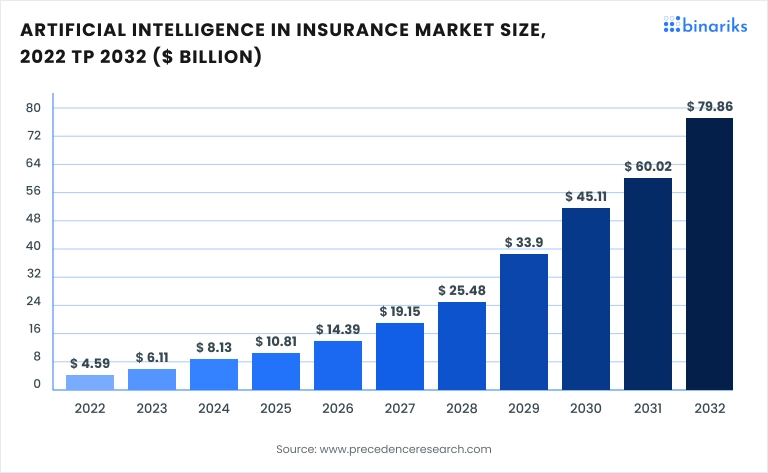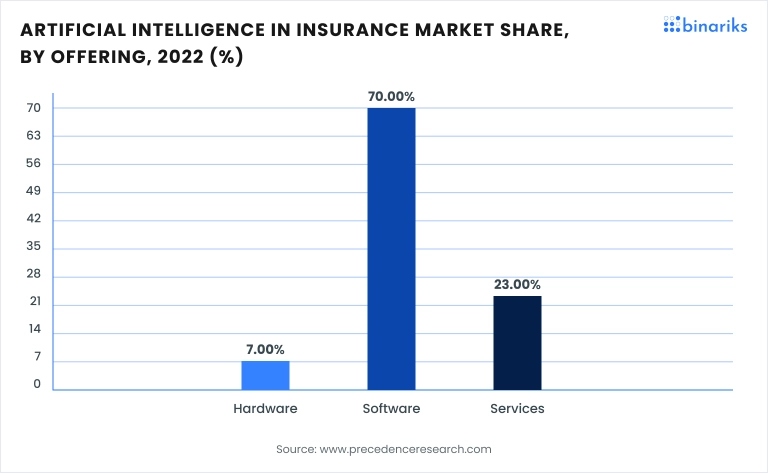Insurance businesses and customer service, in particular, are shifting toward digital transformation like other customer-oriented digital businesses like banking and medicine . AI transforms customer experience for insurance and is the most important digital trend in insurance.
At Binariks, we have experience in full-scale refactoring of the collision management software platform, including a message center for seamless communication between the apps and data storage for the claim administration app.
From experts in AI in customer service in insurance, this article is dedicated to customer service trends, different roles AI plays in customer complaint management, and the exact technologies used.
The landscape of customer service in insurance for 2024
Technological advancements in AI, machine learning, and several other technologies will shape the landscape of customer service in the insurance industry in 2024. Here are some of the trends worth following in 2024:

- There is a rise in InsurTech startups that leverage AI, blockchain, and data analytics to streamline and automate processes and offer personalized services to customers. As of 2022, the market was valued at $5.45 billion and is projected to expand at a compound annual growth rate (CAGR) of 52.7% from 2023 to 2030, according to Ground View research (Source ).
- Insurers focus on creating omnichannel customer experience with a focus on digitalization, which is what the customers of the younger generations value (Source ).
- Predictive insurance analytics and IoT are some of the hottest trends in the industry.
- Human participation remains vital despite the shift to digital strategy, especially in areas like life insurance (Source ).
- The industry is witnessing market consolidation, with private equity firms and venture capitalists acquiring independent agencies. The high return on investment drives this trend these agencies offer, making them attractive acquisition targets. The competitive landscape is influenced by regulatory changes and the entry of new players like big tech companies, leveraging their customer bases and technological capabilities to disrupt traditional insurance models (Source ).

The role of AI for customer complaint management in insurance
AI insurance customer service has an unprecedented role in claim processing and customer service. Here are the many ways it can help insurers and customers transform customer service, explained in great detail.
Automated complaint handling
AI can automatically handle and respond to standard complaints, the most common ones in the insurance industry. Such complaints include acknowledging receipts and providing basic information. Additionally, this can involve some easy stuff like claim status inquiries, basic payment issues, document requests, and auto-renewal queries.
Use case:
For instance, a customer files a complaint via email about a claim process. An AI customer service system can automatically acknowledge the receipt of the complaint, categorize it based on keywords (e.g., "claim delay"), and direct it to the relevant department. This immediate response and routing save time and ensure the right team handles the complaint.
Enhanced analysis of complaint data
AI algorithms can analyze large volumes of complaint data to identify trends. In this way, the insurance companies understand the root causes of complaints, allowing them to address systemic challenges.
Use case:
AI automation customer service analyzes data from multiple sources (claim processing times, customer feedback, etc.) and predicts a potential increase in complaints about delays in claim processing. After that, the team can analyze the claim and allocate more resources to the team that lacks them before the complaints occur.
Sentiment analysis for prioritization
AI in customer service for insurance can analyze the tone and urgency of a complaint submitted through an online portal. If the complaint is identified as being from a highly dissatisfied customer, it can be prioritized for immediate attention.
For example, this can signal that a consumer has a significant security concern that should be addressed within a few hours. Sentiment analysis is critical for customer satisfaction as unresolved critical issues are a source of great distress and say a lot about the quality of customer service. No customer likes to wait for days and months for significant problems to be resolved.
Use case:
A customer submits a complaint via the online portal of an insurance company. The complaint is about a delayed claim processing for a critical medical procedure. The AI system recognizes the tone of the complaint as urgent through NLP, assigns the urgency score, prioritizes the complaint, and works on a prompt response.
Personalized customer interaction
Generative AI in insurance can provide personalized responses to complaints by analyzing the customer's history and the context of the complaint. This personalized approach can make customers feel heard and understood to a level similar to interaction with a real professional.
Use case:
Let's say a customer has filed a complaint against a long-term policyholder with a good record. In this case, an AI system can suggest offering goodwill gestures like expedited claim processing or a premium discount while resolving the consumer's issue.
Predictive analytics
Predictive analytics is a function of AI in customer complaint management that is useful before the issue occurs. With it, AI can anticipate potential complaints by analyzing various customer interaction points and operational data. This way, the issue can be addressed before the formal complaint even occurs.
Use case:
An auto insurance company employs predictive analytics to anticipate and address issues that could lead to complaints about car accident claims. This data comes from many sources, such as past claims, weather reports, and even daily traffic patterns.
Fraud detection and compliance
AI automation customer service plays a role in detecting fraudulent complaints or ensuring compliance with regulatory standards . It can analyze complaint patterns, cross-reference with other data, and flag fraudulent activity.
Use case:
A health insurance company can put a fraud detection system in place. This fraud detection system can use AI and machine learning to analyze fraudulent claims and give them a risk score based on the likelihood of fraud. Claims with high-risk scores are flagged for further investigation. This helps to sort out insufficient fraudulent claims and better handle the real ones.
Embrace InsurTech innovation with custom software development
AI-powered solutions for complaint handling
1. Chatbots
AI-powered or self-service chatbots are the first technology customers encounter when using an insurance service. Handling customer complaints always starts with using these bots.
While every complaint goes through AI-powered chatbots first, the ones that get resolved at this stage are the most common inquiries and complaints, such as claim filing, updating personal information, etc. If a chatbot cannot resolve the issue, the customer can be transferred to a human representative.
2. NLP (Natural Language Processing) and voice analysis technologies
With the help of NLP, the provider can understand complex customer complaints. AI systems have gained the ability to interpret actual human language to get into nuances of complaints.
NLP is the instrument that can get into the sentiment behind a customer's message and judge the urgency of the customer complaint. This makes NLP a crucial instrument in sentiment analysis for prioritization. It is also just as critical in all aspects of complaint analysis.
The principle of work behind voice analysis technologies is similar to how NLP handles sentiments, but it works with voice. Voice analysis programs react when the customer is in a heightened emotional state or when the customer support representative needs to change the attitude subtly and talk more upbeat.
3. Machine learning
ML algorithms can learn from past interactions and outcomes to improve the handling of future complaints. They can identify patterns in the data, such as frequent complaint types. As a result of this analysis, responses are adjusted, and issues are escalated.
Some chatbots, NLP, and machine learning mechanisms are also capable of real-time monitoring, indicating that customers are distressed by certain situations across social media channels and react to them promptly.
Security and compliance considerations
Insurance companies are expected to take extra steps for data protection because there is a lot of sensitive information in insurance, such as personal identification, financial information, and biometric data. Here are some of the primary concerns in AI in customer communications for insurers:
Data protection
Insurance companies deal with vast amounts of sensitive personal data, including financial and health information. AI systems must comply with data protection laws such as the General Data Protection Regulation (GDPR) in Europe and the Health Insurance Portability and Accountability Act (HIPAA) in the United States.
AI model transparency
AI models, especially those based on machine learning, can sometimes be "black boxes." Because of this, it is difficult for decision-makers to understand how these AI models arrive at decisions, particularly in AI for customer service in insurance.
More model transparency requires introducing new policies aimed explicitly at that, but most countries are still in the early stages of development of such policies. AI models should be able to explain why a particular insurance claim was rejected or a specific policy rate was offered to a customer.
Cybersecurity measures
In addition to other threats explained above, insurance companies are vulnerable to cyber threats, such as data breaches and cyber-attacks. Some strategies that help protect companies against cybersecurity include security audits and robust data encryption techniques.
Regular compliance
Aside from the acts that specifically focus on data protection, there are also insurance acts that the AI in customer service is supposed to comply with. Here are some of them:
- National Association of Insurance Commissioners (NAIC)
NAIC is a platform for developing uniform policies regarding state insurance regulation. It includes standards, best practices, and regulatory oversight for insurance companies (Source ).
- Sarbanes-Oxley Act (SOX)
SOX is a federal law that has existed since 2003 in response to corporate and accounting frauds of the late 1990s, like Enron and WorldCom (Source ). Under this act, the investors are protected from fraudulent financial reporting. It also sets transparent rules for corporate disclosures. Some other demands imposed by SOX include strict audit requirements and internal controls.
- Dodd-Frank Wall Street Reform and Consumer Protection Act
This legislation was passed in 2010 as a reaction to the global financial crisis that took place in 2008. The goal was to decrease the overall risks to the financial system in the United States. The act increased government oversight of financial institutions and created new agencies, like the Consumer Financial Protection Bureau, responsible for implementing and enforcing compliance with financial regulations.
It also includes provisions specifically impacting the insurance industry, such as establishing the Federal Insurance Office (FIO) and the Volcker Rule, which restricts how banks can invest.
Tailoring AI solutions for custom insurance software
Looking for AI solutions for AI insurance customer service? The decision on that is a step-by-step process that incorporates the expertise of IT professionals like Binariks.
Step 1: Identify your needs
Start by assessing what exact solutions your AI should have in customer-complaint management targets. These include customer service, claims processing, risk assessment, fraud detection, and policy personalization. There is a unique approach to all of these services in the realm of AI.
Step 2: Data integration
Think of how the AI solutions you are about to present will integrate with existing systems in your company, such as CRM, claim databases, and other customer interaction tools that you might have. AI teams are capable of assisting with this integration.
Step 3: Develop AI models
Based on previously identified needs, your IT team can start developing an AI model that works for your business and product. Some options include machine learning models for risk assessment, NLP algorithms for customer service chatbots, or predictive analytics for fraud detection.
Step 4: Ensure regulatory compliance
Custom AI solutions must adhere to regulatory compliance standards such as GDPR and HIPAA. In addition, some of the AI solutions require robust security protocols. The following steps are regular for most custom software development. They include:
- UI/UX design
- Testing and validation
- Integration with existing systems
- Solutions for scalability
- Maintenance
Experts at Binariks have in-depth experience with all steps of AI insurance customer service development and can assist you every step of the way. Some of our services include self-service customer portals, telematics insurance, client management surveys, real-time predictive analytics, and agency-managed systems.
Insurtech Application
We built a scalable, user-friendly frontend and refactored the platform code.
Final thoughts
The future of AI in customer insurance holds several promising developments and trends. We can expect enhanced personalization with individual coverage of each client, more enhanced instruments of predictive analytics, and more robust integration with IoT. AI will also provide insurers with tools to enhance customer engagement and retention.
If you are looking for a suitable partner to develop a customer security service, Binariks is the right one. Some of our services include self-service customer portals, telematics insurance, client management surveys, real-time predictive analytics, and agency-managed systems.
Share

